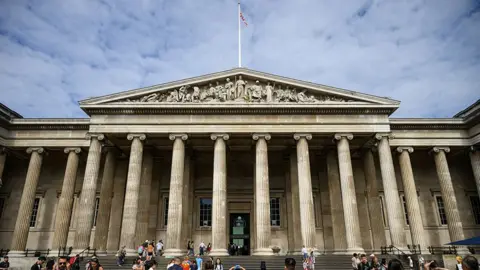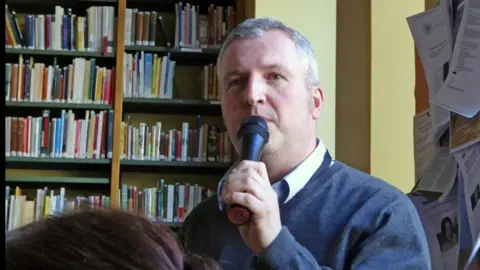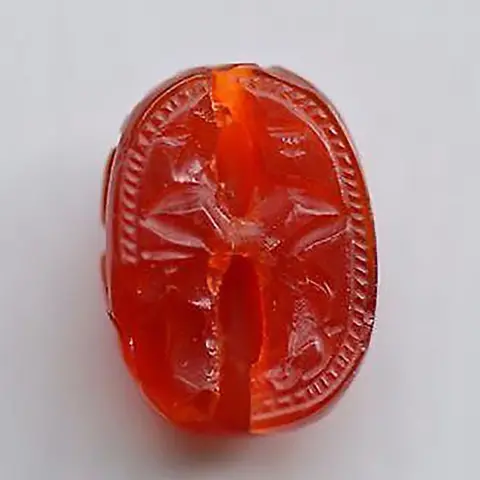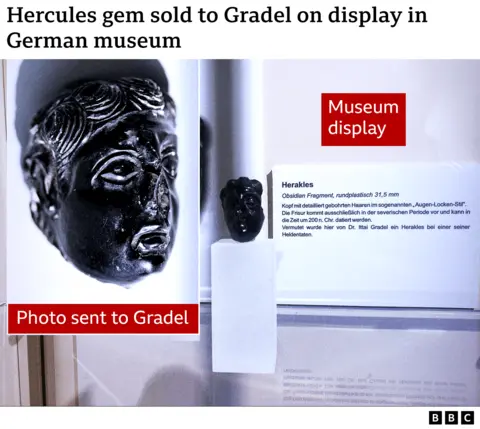Katie Razzall, Darin Graham and Larissa Kennelly,BBC News
 BBC
BBCThe FBI is investigating the sale to US buyers of what are suspected to be hundreds of treasures from the British Museum.
The BBC understands the US law enforcement agency has also assisted with the return of 268 items, which the museum claims belong to it, that were sold to a collector in Washington DC.
The British Museum announced last year that ancient gems, jewellery and other items from its collection, were missing, stolen or damaged.
One buyer, based in New Orleans, told the BBC an FBI agent had emailed him asking for information about two pieces he had bought on eBay.
The FBI agent said they were assisting the Metropolitan Police with investigating missing or stolen items from the museum.
The buyer has said he is no longer in possession of either gem and does not believe they have been located by authorities. The FBI did not request further information from him.
 Getty Images
Getty ImagesThe British Museum says of 1,500 items it estimates are stolen or missing, 626 have so far been recovered and 100 more have been found but not yet brought back.
The vast majority of items the museum believes to have been stolen were uncatalogued and it is still in the process of looking for ways to prove they come from its collection. In some cases, this involves collectors agreeing to donate items to the museum so staff can assess.
A senior curator, Peter Higgs, is accused by the British Museum of stealing, damaging, melting down, and selling ancient artefacts. He denies the allegations.
The museum has said it believes Dr Higgs pocketed an estimated £100,000 in total.
According to court documents in a civil case the museum is bringing against Dr Higgs, it believes he was stealing items for at least a decade, selling mostly unregistered items from the museum’s storerooms.
The museum believes Dr Higgs, who has been dismissed, had sold items to at least 45 buyers on eBay.
Dr Higgs is defending the civil claim against him.
Nobody has been arrested or charged with any offence.

Three buyers have said the seller “sultan1966” presented himself as “Paul Higgins” or “Paul” on eBay or over email with them.
According to the court documents, the museum says Dr Higgs admitted the account sultan1966 belonged to him.
The New Orleans buyer, Tonio Birbiglia, told the BBC he had bought two items from sultan1966.
We confirmed this by cross-referencing the eBay records referred to by the FBI with Mr Birbiglia’s receipts.
The British Museum has not yet examined these items, so is yet to determine if they were from its collection.
One was an amethyst gem depicting a Cupid – the Roman god of love – riding a dolphin, which Mr Birbiglia bought for £42 in May 2016.
The other was an orange scarab-beetle gem he bought for £170. Mr Birbiglia sent his payment for this item to a PayPal account registered under Dr Higgs’ personal email address.

Mr Birbiglia, who worked for an antiquities gallery at the time, said he was “completely shocked” when the FBI contacted him. He said he probably bought the gems in order to sell them on, adding “I can’t even remember any of it”.
Mr Birbiglia told the special agent he could not remember anything about the gems. He asked the FBI for more information, such as pictures, so that he could try to identify where they may have ended up.
Neither the FBI agent, the museum or British police followed up with him – said Mr Birbiglia – so the two gems have not yet been tracked down by the authorities.
“The whole thing just seemed like they [the FBI] were blowing it off,” he said. “He [the agent] didn’t try very hard.”
The BBC understands the FBI has also assisted with the investigation of 268 items in the Washington DC area that were sold by the same seller.
A source close to the buyer told the BBC he bought items from sultan1966 over eBay – subsequently dealing directly with the same seller by email – and that he paid up to £7,000 for the items. According to the source, the seller used the name of “Paul Higgins” during the transactions.
The BBC believes gems have now been handed over to the British Museum, where work to prove ownership is ongoing.
But the US is not the only place where items sold by the seller may have ended up.
Danish antiquities dealer Dr Ittai Gradel, who first alerted the museum to thefts, has tracked down artefacts that were sold to buyers in several cities – including Hamburg, Cologne, Paris and Hong Kong.
Some of the gems which he bought himself in good faith, and then sold on to another private collector, ended up on display in the Deutsches Edelsteinmuseum in Idar-Oberstein, Germany. They were on loan to the museum for an exhibition.
One gem is thought to be a rare, 2nd Century head of the Greek hero Hercules made from obsidian, a type of volcanic glass.
Estimated to be worth thousands of pounds, the gem was one of the prize exhibits and appeared as a full-page photograph at the beginning of the exhibition’s catalogue.

In 2017, Dr Ittai Gradel paid £300 for the item, which was offered in a private deal under the alias Dr Higgs used – Paul Higgins.
In emails seen by the BBC, Dr Gradel was told by the seller it belonged to his sibling who had inherited it from their grandmother.
“I think it’s glass – very nicely-modelled little head, about 3cm high. I don’t know if you are interested in things like this, but if you are, we are open to offers,” the seller wrote.
The two gems are uncatalogued, but the British Museum believes they come from its collection. They have since been brought back to the UK and handed over to museum staff.




